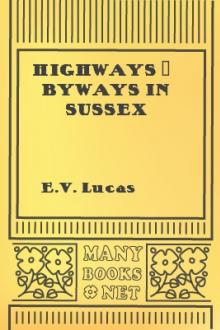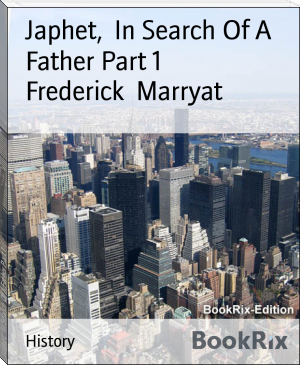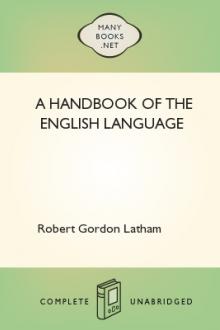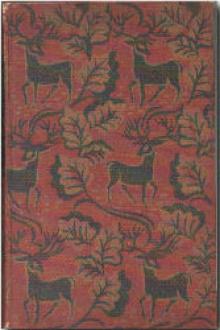Highways & Byways in Sussex by E. V. Lucas (e reader pdf best .txt) 📕

- Author: E. V. Lucas
- Performer: -
Book online «Highways & Byways in Sussex by E. V. Lucas (e reader pdf best .txt) 📕». Author E. V. Lucas
In losing your way in this neighbourhood do not ask the passer-by for Selmeston, but for Simson; for Selmeston, pronounced as spelt, does not exist. Sussex men are curiously intolerant of the phonetics of orthography. Brighthelmstone was called Brighton from the first, although only in the last century was the spelling modified to agree with the sound. Chalvington (the name of a village north of Selmeston) is a pretty word, but Sussex declines to call it other than Chawton. Firle becomes Furrel; Lewes is almost Lose, but not quite; Heathfield is Hefful. It is characteristic of a Sussex man that he always knows best; though all the masters of all the colleges should assemble about him and speak reasoningly of Selmeston he would leave the congress as incorrigible and self-satisfied a Simsonian as ever.
Many years ago Selmeston churchyard possessed an empty tomb, in which the smugglers were wont to store their goods until a favourable time came to set them on the road. Any objections that those in authority might have had were silenced by an occasional tub. But of this more in the next chapter.
And so we come to Alfriston; but, as I said, the right way was over the hills, ascending them either at Itford (crossing the Ouse at Southease) or by that remarkable combe, one of the finest in Sussex, with an avenue leading to it, which is gained from a lane south of Beddingham. Firle Beacon's lofty summit is half-way between Beddingham and Alfriston, and from this height, with its magnificent view of the Weald, we descend steadily to the Cuckmere valley, of which Alfriston is the capital.
Alfriston, which is now only a village street, shares with Chichester the distinction of possessing a market cross. Alfriston's specimen is, however, sadly mutilated, a mere relic, whereas Chichester's is being made more splendid as I write. Alfriston also has one of the oldest inns in the county—the "Star"—(finer far in its way than any of Chichester's seventy and more); but Ainsworth was wrong in sending Charles II. thither, in Ovingdean Grange. It is one of the inns that the Merry Monarch never saw. The "Star" was once a sanctuary, within the jurisdiction of the Abbot of Battle, for persons flying from justice; and it is pleasant to sit in the large room upstairs, over the street, and think of fugitives pattering up the valley, with fearful backward glances, and hammering at the old door. One Birrel, in the reign of Henry VIII., having stolen a horse at Lydd, in Kent, took refuge here. The inn in those days was intended chiefly for the refreshment of mendicant friars.
In 1767 the landlord was, according to a private letter, "as great a curiosity as the house." I wish we had some information about him, for the house is quaint and curious indeed, with its red lion sentinel at the side (figure-head from a Dutch wreck in Cuckmere Haven), and its carvings inside and out. The old and the new mingled very oddly when I was lately at Alfriston. Hearing a familiar sound, as of a battledore and a ball, in one of the rooms, I opened the door and discovered the landlord and a groom from the racing stables near by in the throes of the most modern of games, amid surroundings absolutely mediæval.
The size of the grave and commanding church, which has been called the cathedral of the South Downs, alone proves that Alfriston was once a vastly more important place than it now is. Legend says that the foundations were first cut in the meadow known as Savyne Croft. There day after day the builders laid their stones, arriving each morning to find them removed to the Tye, the field where the church now stands. At last the meaning of the miracle entered their heads, and the church was erected on the new site. Its shape was determined by the slumbers of four oxen, who were observed by the architect to be sleeping in the form of a cross. Poynings church, under the Dyke Hill, near Brighton, was built, it has been conjectured, by the same architect. Within the cathedral of the South Downs, which is a fourteenth century building, is a superb east window, but it has no coloured glass. The register, beginning with 1504, is perhaps the oldest in England. Hard by the church is the simple little clergy house—unique in England, I believe—dating from pre-Reformation times. It has lately been very carefully restored.
Alfriston once had a scholar in the person of Thomas Chowne, of Frog Firle, the old house on the road to Seaford, about a mile beyond the village. Chowne, who died in 1639, and was buried at Alfriston, is thus touched off by Fuller:—"Thomas Chune, Esquire, living at Alfriston in this County, set forth a small Manuall, intituled Collectiones Theologicarum Conclusionum. Indeed, many have much opposed it (as what book meeteth not with opposition?); though such as dislike must commend the brevity and clearness of his Positions. For mine own part, I am glad to see a Lay-Gentleman so able and industrious." Chowne's great great grandson, an antiquary, one night left some books too near his library fire; they ignited, and Frog Firle Place was in large part destroyed. It is now only a fragment of what it was, and is known as Burnt House.
An intermediate dweller at Frog Firle was one Robert Andrews, who, when unwell, seems to have been attended by William Benbrigg. Miss Florence A. Pagden, in her agreeable little history of Alfriston, from which I have been glad to borrow, prints two of Mr. Benbrigg's letters of kindly but vague advice to his patient. Here is one:—
"Mr. Andrews,
"I have sent you some things which you may take in the manner following, viz.:—of that in the bottle marked with a + you may take of the quantity of a spoonfull or so, now and then, and at night take some of those pills, drinking a little warm beer after it, and in the morning take 2 spoonfulls of that in —— bottle fasting an hour after it, and then you may eat something, you may take also of the first, and every night a pill, and in the morning. I hope this will do you good, which is the desire of him who is your loving friend,
"Wm. Benbrigg."
Alfriston once had a race meeting of its own—the course is still to be seen on the southern slope of Firle Beacon—and it also fostered cricket in the early days. A famous single-wicket match was contested here in 1787, between four men whose united ages amounted to 297 years. History records that the game was played with "great spirit and activity." Mr. Lower records, in 1870, that the largest pear and the largest apple ever known in England were both grown at Alfriston, but possibly the record has since been broken.
The smallest church in Sussex is however still to Alfriston's credit, for Lullington church, on the hill side, just across the river and the fields to the east of Alfriston church, may be considered to belong to Alfriston without any violence to its independence. As a matter of fact, the church was once bigger, the chancel alone now standing. What Charles Lamb says of Hollington church in Chapter XXXVI. of this book, would be more fitting of Lullington.
We have come to Alfriston from Lewes, proposing to return there; but it might well be made a centre, so much fine hill country does it command. Alfriston to Seaford direct, over the hills and back of the cliffs and the Cuckmere valley; Alfriston to Eastbourne, crossing the Cuckmere at Litlington, and beginning the ascent of the hills at West Dean; Alfriston to Lewes over Firle Beacon; Alfriston to Newhaven direct; Alfriston to Jevington and Willingdon;—all these routes cover good Down country, making the best of primitive rambles by day and bringing one at evening back to the "Star," this mediæval inn in the best of primitive villages. Few persons, however, are left who will climb hills—even grass hills—if they can help it; hence this counsel is likely to lead to no overcrowding of Fore Down, The Camp, Five Lords Burgh, South Hill, or Firle Beacon.
I might here, perhaps, be allowed to insert some verses upon the new locomotion, since they bear upon this question of walking in remote places, and were composed to some extent in Sussex byways in the spring of 1903:—
A SONG AGAINST SPEED.
To return to Alfriston, there are two brief excursions (possible in the vehicles that are glanced at in the foregoing verses) which ought to be described here: to Alciston and to Wilmington. Alciston is a little hamlet under the east slope of Firle Beacon, practically no more than a farm house, a church, and dependant cottages. It is on a road that leads only to itself and "to the Hill" (as the sign-boards say hereabout); it is perhaps as nearly forgotten as any village in the county; and yet I know of no village with more unobtrusive charm. The church, which has no vicar of its own, being served from Selmeston, a mile away, stands high amid its graves, the whole churchyard having been heaped up and ramparted much as a castle is. In the hollow to the west of the church is part of the farmyard: a pond, a vast barn with one of the noblest red roofs in these parts, and the ruins of a stone pigeon house of great age and solidity, buttressed and built as if for a siege, in curious contrast to the gentle, pretty purpose for which it was intended. Between the church and the hill, and almost adjoining it, is the farmhouse, where the church keys are kept—a relic of Alciston Grange (once the property of Battle Abbey)—with odds and ends of its past life still visible, and a flourishing fig-tree at the back, heavy with fruit when I saw it under a September sun. The front of the house looks





Comments (0)